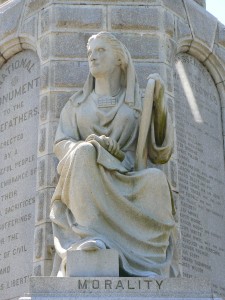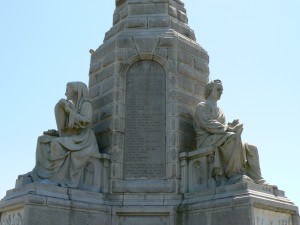A granite monument standing 81 feet tall honors the first English settlers to land in Plymouth, Mass. The National Monument
to the Forefathers stands in a state park on Allerton Street. The monument, the largest solid-granite monument in the United
States, was dedicated in 1889 (30 years after its cornerstone was laid). A dedication on the monument’s northeast face
reads, “National Monument to the Forefathers. Erected by a grateful people in remembrance of their labors, sacrifices
and sufferings for the cause of civil and religious liberty.”
 The monument features several allegorical figures depicting virtues the Pilgrims, known in Plymouth as the Forefathers, brought
with them when they arrived in Massachusetts in 1620. The largest figure, Faith, is 36 feet tall and weighs 180 tons by itself.
Faith, holding a Bible, stands atop a granite column facing toward Plymouth Harbor and England. (The osprey nest on Faith’s
head is not part of the original design.)
The monument features several allegorical figures depicting virtues the Pilgrims, known in Plymouth as the Forefathers, brought
with them when they arrived in Massachusetts in 1620. The largest figure, Faith, is 36 feet tall and weighs 180 tons by itself.
Faith, holding a Bible, stands atop a granite column facing toward Plymouth Harbor and England. (The osprey nest on Faith’s
head is not part of the original design.)
The eight-sided column features four buttresses
with seated 15-foot-tall allegorical figures. Moving counterclockwise from the monument’s front, the north face features
a representation of Morality, a woman holding a tablet bearing the beginning of the Ten Commandments, “I am the Lord
thy God.” Niches in the base of Morality’s throne honor prophecy and evangelism.
The west face depicts Law, a man holding a book.
Law is flanked by smaller figures depicting justice and mercy.  Education graces the south face with a woman pointing to a book in her lap. Representations of wisdom and youth flank Education’s
throne.
Education graces the south face with a woman pointing to a book in her lap. Representations of wisdom and youth flank Education’s
throne.
The east face features a representation of Liberty,
a seated warrior with a sword in his right arm and a broken chain in his left. He is flanked by depictions of peace and tyranny,
symbolizing the defeat of tyranny and the resulting peace.
Along with the allegorical figures, the monument’s
buttresses also feature bas-relief sculptures depicting scenes such as the Pilgrims departing England and landing on the shores
of Plymouth and interacting with Native Americans. The side of the monument’s face also bears panels listing the names
of the Pilgrim settlers, and a quote from William Bradford, a governor of the colony. The monument was designed primarily
by Boston sculptor Hammatt Billings whose original design called for it to be nearly twice as high at 150 feet (just under
the Statue of Liberty’s height, including the pedestal, of 151 feet).
 The monument’s height was reduced when funding became short during the Civil War. The monument was commissioned by the
Pilgrim Society, which maintained the monument and the small park surrounding it until the site was deeded to the commonwealth
in 2001.
The monument’s height was reduced when funding became short during the Civil War. The monument was commissioned by the
Pilgrim Society, which maintained the monument and the small park surrounding it until the site was deeded to the commonwealth
in 2001.

